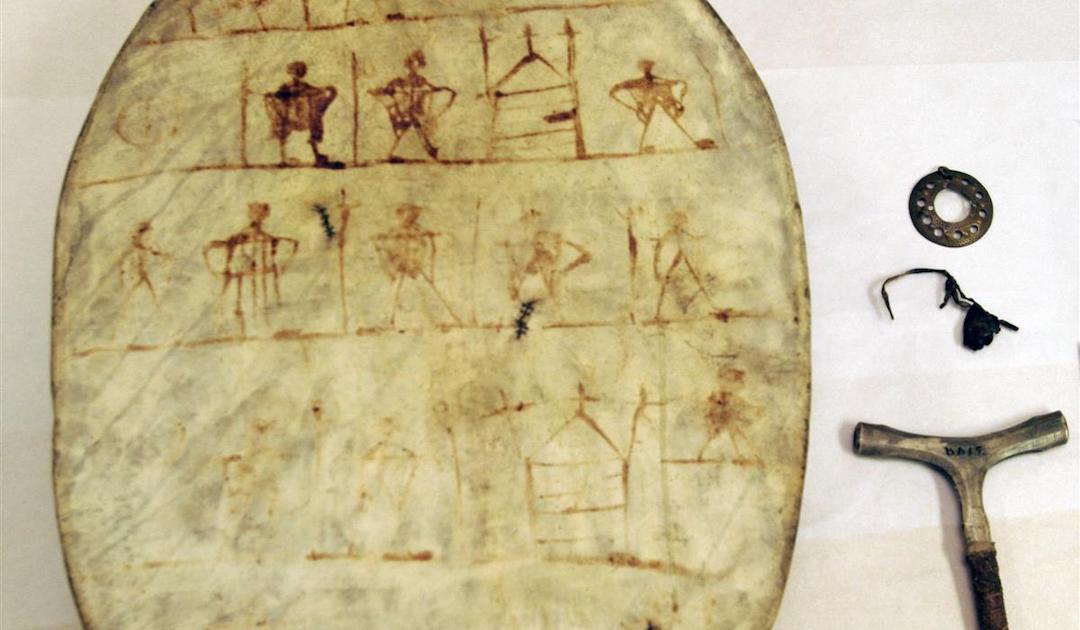
Possession, it is said, is nine-tenths of the law. When it comes to cultural items, it is impossible to underestimate the significance the final tenth. To get a sense of why, consider the meavresgárri, a Sámi hand drum, that led to its owner, a 17th shaman named Poala-Ánde, to be tried as a witch and murdered while waiting to be executed.
Since 1979, Poala-Ánde’s drum (pictured above) has had pride of place at RiddoDuottarMuseat, a Sámi collection in Karasjok, Norway, where it is on display as one of the few examples of an original historic meavresgárri that is in Sámi possession. Making it even more valuable is that much about its history, and the history of the person who used it, is known.
Until this week, though, Poala-Ánde’s meavresgárri remained the legal property of Denmark’s Nationalmuseet. What’s more, because Nationalmuseet does not lend out items permanently, RiddoDuottarMuseat has had to request every five years to have its permission to display it renewed. Though Denmark has agreed each time, Sámi representatives had come to consider having to request permission to hang on to a Sámi artefact demeaning, according to reporting by VG, a Norwegian news outlet that has covered the matter closely.

Poala-Ánde’s meavresgárri has been in Danish possession since 1692, when it was sent to Copenhagen to be added to the collection of the Danish king, who then also ruled Norway. It had been taken away from Poala-Ánde while he was being tried for witchcraft after he demonstrated how it could be used to reverse curses, ease labour pains or ensure the health of reindeer herds. Found guilty, he was sentenced to be burned alive, but died instead after being attacked by an axe-wielding guard.
RiddoDuottarMuseat’s decision to ask Nationalmuseet to hand over Poala-Ánde’s meavresgárri came after what appeared to have been only a tentative renewal in 2016, and culminated in a letter being sent to the Danish queen in October by the then president of Sámediggi, Norway’s Sámi assembly, asking her to intervene when it appeared no progress was being made in the matter.
Nationalmuseet, for its part, agreed with RiddoDuottarMuseat on two key points: that the meavresgárri is “unique source of historic knowledge about Sámi rituals and religion”, and that it belonged in Norway. But handing over items to foreign countries, even when the case for doing so is clear, is a time-consuming process. Nationalmuseet is permitted to hand over items in its collection to countries and cultural groups that have a rightful claim — and, indeed, has done so, sending items back to Greenland and Iceland, both former colonies — but transferring them to another country requires that a number of criteria are met, including whether it can be stored properly, a criteria that has led to some Greenlandic items still being held at sites in Denmark. Final permission must be granted by the minister of culture, making the decision subject to politcal considerations.
In the case of Poala-Ánde’s meavresgárri, the matter was straightforward, and was approved, in part, because it had been in RiddoDuottarMuseat’s possession for so long.
“It’s only natural that the drum’s permanent home be the museum it has a historic tie to, and where it has otherwise been on display for years,” Ane Halsbo-Jørgensen, the culture minister, said.
Kevin McGwin, PolarJournal
More about this topic





